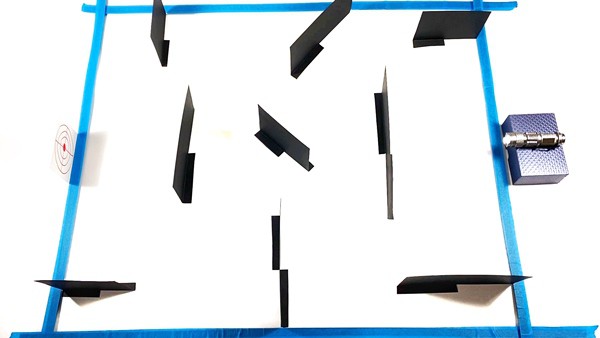Summary
Part 1 of this lesson is based on the "Reflection on Light" activity from California State University, Long Beach.
Overview
When light interacts with an object, it can be absorbed, transmitted, or reflected. This lesson focuses on materials that reflect light. Specifically, students will use mirrors and flashlights to investigate how light is reflected from a surface. By doing that, they will discover that when a light ray hits a reflective surface, its angle of incidence is equal to the angle of reflection, which is stated by the law of reflection. Students will then use their gained knowledge in a mirror maze challenge where they have to find a way to guide a light beam through a maze in order to hit a specific target.
Remote Learning: This lesson plan can be conducted remotely. The Engage section of the lesson can be done over a video call, then students can work individually and independently during the Explore sections, using the student worksheet and the maze template as guide. A set of materials can be prepared in advance or students can use materials found around the house. For example, old CDs can work as mirror replacements. The Reflect sections can be done over another video call. Students can show their final design solution either on the call or they can share pictures or drawings of their designs on a class drive.
Learning Objectives
- Understand and explain the law of reflection.
- Guide a light beam through a maze using mirrors.
- Construct and describe a diagram of the light's path as it bounces off reflective surfaces.
NGSS Alignment
This lesson helps students prepare for these Next Generation Science Standards Performance Expectations:- MS-PS4-2. Develop and use a model to describe that waves are reflected, absorbed, or transmitted through various materials.
- MS-ETS1-4. Develop a model to generate data for the iterative testing and modification of a proposed object, tool, or process such that an optimal design can be achieved.
|
Science & Engineering Practices
Planning and Carrying out Investigations.
Conduct an investigation and/or evaluate and/or revise the experimental design to produce data to serve as the basis for evidence that meet the goals of the investigation.
Constructing Explanations and Designing Solutions. Construct a scientific explanation based on valid and reliable evidence obtained from sources (including the students' own experiments) and the assumption that theories and laws that describe the natural world operate today as they did in the past and will continue to do so in the future. Undertake a design project, engaging in the design cycle, to construct and/or implement a solution that meets specific design criteria and constraints Apply scientific ideas or principles to design, construct, and/or test a design of an object, tool, process or system Engaging in Argument from Evidence. Evaluate competing design solutions based on jointly developed and agreed-upon design criteria. |
Disciplinary Core Ideas
PS4.B: Electromagnetic Radiation.
When light shines on an object, it is reflected, absorbed, or transmitted through the object, depending on the object's material and the frequency (color) of the light.
ETS1.B: Developing Possible Solutions. A solution needs to be tested, and then modified on the basis of the test results, in order to improve it. Sometimes parts of different solutions can be combined to create a solution that is better than any of its predecessors. ETS1.C: Optimizing the Design Solution. The iterative process of testing the most promising solutions and modifying what is proposed on the basis of the test results leads to greater refinement and ultimately to an optimal solution. |
Crosscutting Concepts
Patterns.
Patterns can be used to identify cause and effect relationships.
Cause and Effect: Mechanism and Prediction. Cause and effect relationships may be used to predict phenomena in natural or designed systems. |
Materials
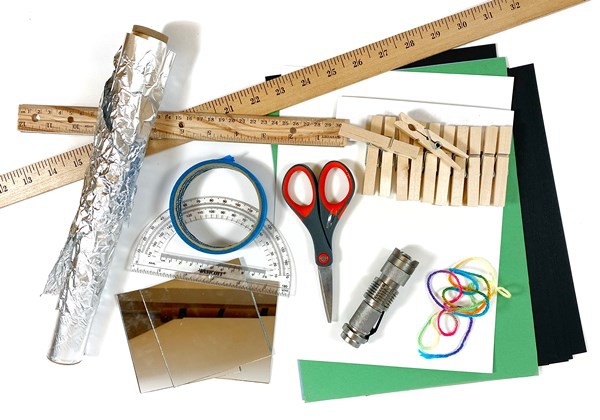 Image Credit: Svenja Lohner, Science Buddies / Science Buddies
Image Credit: Svenja Lohner, Science Buddies / Science Buddies
Per Student Group of 2–3:
- One flashlight with a narrow beam
- 3 small mirror squares (4" x 4")
- 3 squares of aluminum foil (4" x 4")
- 3 pieces of string (about 5" long)
- Colored construction paper (1 sheet)
- 12 clothespins or binder clips
- Masking tape or painter's tape
- Protractor
- Ruler
- Yardstick
- Black cardstock paper (7 sheets)
- One printed maze template
- One printed and cut target from the target template
For Teacher:
- Scissors
- Ruler
- Small mirror square (4" x 4")
- Flashlight with a narrow beam
- Construction paper (1 sheet)
- Piece of string (about 5 inches long)
Background Information for Teachers
This section contains a quick review for teachers of the science and concepts covered in this lesson.Light mostly travels through space in straight lines. This is why, in physics, the concept of light rays is commonly used. In this concept, a light ray is represented as a straight line or arrow pointing away from the light source, which indicates the direction of light (Figure 1, left). A bundle of parallel light rays is called a beam of light (Figure 1, right). Picturing light as lines makes it possible to illustrate what happens if light hits an object that is in its way.
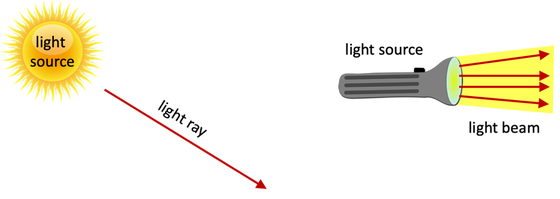 Image Credit: Svenja Lohner, Science Buddies / Science Buddies
Image Credit: Svenja Lohner, Science Buddies / Science Buddies
Figure 1. A straight arrow traveling from a light source depicts a light ray (left) and a group of arrows represents a light beam (right).
Materials can interact with light in different ways. Once light hits a material, the light can either be absorbed, transmitted, or reflected. Often, a combination of absorption, transmission, and reflection happens. How we see a material depends on how the light interacts with the object. We can only see materials that reflect or bounce back at least some light, or materials that emit light themselves. The reflection of light is similar to the bouncing of a ball in that the angle at which the light hits the reflecting surface is identical to the angle at which it bounces off of it (Figure 2). This circumstance is called the law of reflection. The angle that is formed by the light hitting the reflecting surface and the normal line (the line orthogonal to the surface) is called the angle of incidence, whereas the angle between the light bouncing back from the reflective surface and the normal line is called the angle of reflection. Both angles are always equal. Also, the reflected ray, the incident ray, and the normal line all lie in the same plane, the plane of incidence (Figure 2).
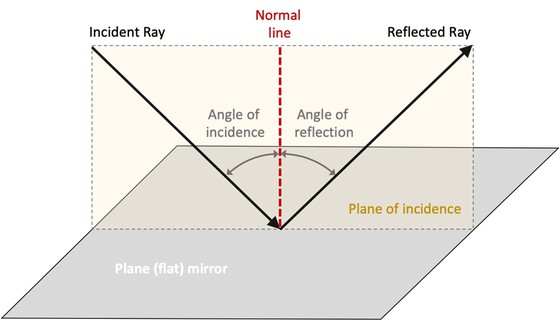 Image Credit: Svenja Lohner, Science Buddies / Science Buddies
Image Credit: Svenja Lohner, Science Buddies / Science BuddiesA grey trapezoid represents a plane mirror. A line perpendicular to the mirror depicts the normal line. Two arrows pointing at an angle toward the mirror and away from the mirror represent the incident ray and the reflected ray. The angle of incidence and angle of reflection are equal. A rectangle illustrates the plane of incidence.
Figure 2. The law of reflection states that when a light ray hits a reflective surface, its angle of incidence is equal to its angle of reflection.
A mirror is a perfect example of reflection on a smooth material. Because it is so smooth, all light reflects at the same angle (Figure 3, middle) giving the material a shiny appearance. Materials that do not have a smooth surface reflect light in a diffuse way (Figure 3, right). Bumps on their surfaces cause light to reflect in many directions. These materials appear matte.
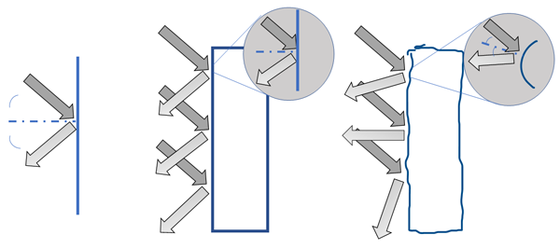 Image Credit: Sabine De Brabandere, Science Buddies / Science Buddies
Image Credit: Sabine De Brabandere, Science Buddies / Science Buddies
Figure 3. Illustrations of how light reflects on shiny (middle) and matte (right) surfaces.
Using the law of reflection, you can predict where a light ray will go after hitting a smooth, reflective surface such as a mirror. In fact, you can draw a diagram of the light's path through a mirror maze if the incident angle for the first mirror is known. An example of such a diagram is shown in Figure 4.
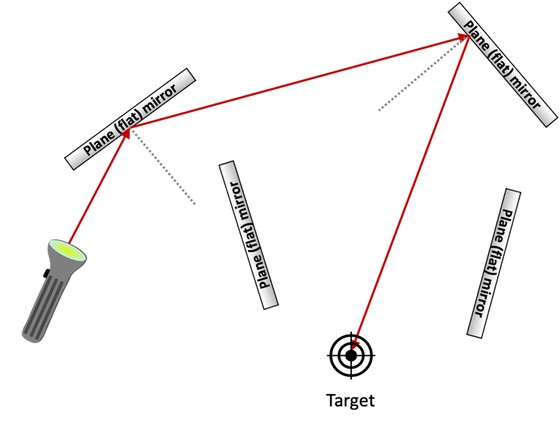 Image Credit: Svenja Lohner, Science Buddies / Science Buddies
Image Credit: Svenja Lohner, Science Buddies / Science Buddies
Figure 4. A diagram showing the path of light through a mirror maze.
In this lesson, students will first investigate the law of reflection with mirrors, construction paper, and a flashlight. Then they will use their gained knowledge in a mirror maze challenge, where they have to use several mirrors to guide a light beam through a maze to hit a specific target.


